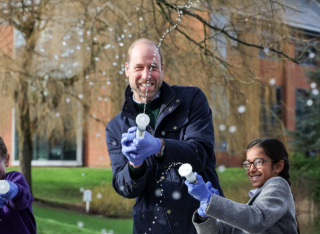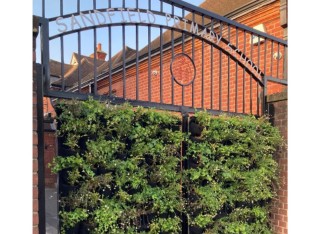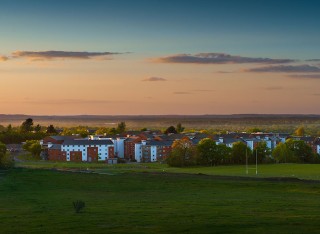

Civic partnerships and facts
The University, as an anchor institution in the town, is integrally involved in the development of its industry and society and has always been committed to effective civic partnership.
Latest activity
Our joint working
The University works collaboratively with Guildford Borough and wider Surrey preparing for the opportunities and challenges of the future. At the same time, working to ensure all members of the local community, particularly those less advantaged, have the opportunity for a positive future.
The following provides details of our most recent joint working.
Community discussion
As a member of the nation-wide Civic University Network, we are currently creating our own Civic University Agreement for Guildford, Surrey and other key regional partners. This will be a civic strategy helping to bind together past achievements, current partnerships and new opportunities rooted in a robust and reciprocal support of local needs and developments, and co-created with local partners to formalise our ‘anchor institution’ status locally and regionally.
Learn more about the benefits of the Civic University Network.
Leading the sector on sustainability
At Surrey, we are embedding sustainability in our day-to-day operations, teaching and research on campus, whilst setting ourselves challenging targets to reduce our environmental impact and helping to drive change in the local community.
The University is highly regarded internationally for its sustainability achievements and made rapid progress to rise to 86th place in 2024 in the Times Higher Education Global Impact Rankings, the only global performance table assessing universities against the UN Sustainable Development Goals (SDGs).
In November 2019, we were highlighted as one of 27 UK universities ‘leading the sector’ with a progressive target for carbon reduction by a coalition of groups Students Organising for Sustainability, University and Colleges Union and People and Planet.
Target net zero
In January 2020, the University agreed to the incredibly challenging target of achieving a Net Zero carbon target by 2030. Our plan for reaching this includes continuing to reduce our energy demand, increasing the proportion of our renewable sources and procuring our energy from renewable energy projects. Learn more about our fight against climate change.
In May 2021 Guildford Borough Council announced that planned changes to the Sustainable Movement Corridor at Tesco junction were cancelled due to the University changing direction about providing the necessary land on the basis of new evidence.
The University and Guildford Borough Council worked together for some years to make changes to this junction but the plans that were brought through in late 2020 had unexpectedly been amended to reduce the scope and the cost of the scheme. Rather than improve the traffic conditions in the area, the University’s investigations show that there would be severe detriment to the companies on the Research Park and the communities in the area.
The University commissioned independent experts to investigate the proposals and their reports showed that the University’s concerns were valid, and that significant damage would be caused to local traffic. We have repeatedly sought to discuss these concerns with Guildford Borough Council and remain willing to continue these conversations when the situation allows.
We remain committed to working with Guildford Borough Council, Surrey County Council, the Royal Surrey County Hospital and others to deliver an integrated solution that solves rather than exacerbating local traffic issues in Guildford.
Our legal obligations and the University’s Green Travel Plan both aim to reduce single occupancy car travel by actively encouraging staff and students to adopt more sustainable travel modes such as car sharing, public transport, walking and cycling.
The University operates a parking exclusion zone within Guildford that restricts access from those who live locally unless they have an essential need to travel by car. Resident students are not eligible to bring their cars to campus unless they have a medical or caring need.
Large events are managed with transport arrangements that actively encourage more sustainable journeys to campus. Policies that support flexible working and hybrid learning have further reduced the need to travel by car.
Working hard on student accommodation
We estimate that in 2019-20 there were 12,770 full-time Surrey students studying on campus who may have required accommodation in Guildford. Of these, approximately 6,007 students were living in university owned accommodation on campus and 525 living in university managed accommodation.
674 new student rooms were delivered in 2019-20 in the latest phase of a multi million pound investment in accommodation on the Manor Park campus. The investment in new student accommodation over the three years to September 2019 was £80 million during which a total of 1,153 new rooms were delivered. During 2019-20, there was a £5.8 million spend on the refurbishment of existing accommodation blocks.
The University is aware of and shares resident concerns around the concentration and impact of student lets and larger houses of multiple occupation’s (HMO’s) in various parts of Guildford. We work with landlords, letting agents, Surrey Police and Guildford Borough Council to tackle issues of poor building maintenance, anti-social behaviour and waste issues that can arise in some of these areas.
The University does not have control over which houses in Guildford are let to our students, nor does it have influence or control over the number of student let properties in any given area. It shares resident concerns where, in some areas too many student houses can cause the ratio between full time resident homes and student lets to become unbalanced and is supportive of Guildford Borough Council in applying fair legislation to control the numbers of student lets in certain areas if it chooses to do so.
The University takes a proactive stance on dealing with issues around our students living off campus. We communicate with students about their safety and behaviour off campus via regular e-communications, an annual 'Shh' campaign in student areas, an annual ‘Living off campus’ guide from our Students’ Union and nightly street marshal patrols. In addition, we have a robust procedure where all allegations and complaints from the public are dealt with within our Student Disciplinary Regulations.
Planning matters
Stag Hill
By the beginning of the 1960s, the then Battersea College had outgrown its main building in Battersea Park Road, London and in 1962 it was decided to move the institution to Guildford. Shortly afterwards, in 1963, the Robbins Report proposed that Battersea College should expand and become a university awarding its own degrees.
The University received its Royal Charter and planning permission to build on its Stag Hill and Manor Park campuses in 1966 and began construction of the 30 ha (74 acres) on Stag Hill in the same year. Students continued to alternate between the original Battersea campus and the new Stag Hill campus until 1970.[28] The further 90 ha (222 acres) allocated to the University on Manor Park remained relatively undeveloped until 2005 when the Manor Park campus began to be built.
Manor Park
Having purchased Manor Farm in mid 1960’s and received planning permission for it as part of the establishment of the University of Surrey, the University found itself in 1987 with a new Local Plan which whilst it did not limit the development of the Manor Park campus did put the land in the green belt. Government Policy changed in the early 1990’s that then prevented the further development of the Manor Park campus and it was only in the 2003 Local Plan that the original position was restored.
Given the space constraints on Surrey’s main Stag Hill campus, in the 2000s the University therefore was able to expand its activities on the Manor Park campus. A little over a mile from Stag Hill and connected to it by a network of footpaths and cycle paths, Manor Park is now home to a large area of student accommodation, as well as Surrey Sports Park and the School of Veterinary Medicine.
The Royal Surrey County Hospital plans for a multi storey car park
The University of Surrey is a close neighbour and valued academic partner of the Royal Surrey County Hospital. The University recognises the need for professionally delivered and operated parking solutions for hospital staff and patients and would like to work with the borough and the hospital to see this achieved in ways that do not do damage to the communities around it.
The plans that the hospital brought forward in 2021 however, ignore critical elements such as traffic impacts, access issues and design quality. The impact and damage to businesses on the Surrey Research Park, students in the accommodation that will now be overlooked and the University itself are matters which we believe should be taken seriously and the University and the Research Park have therefore objected to the scheme and called for the hospital to work with its neighbours to adjust the plans. The adjustments and mitigations required to make the scheme work well are insignificant compared to the costs to others of the submitted plans.
In the Guildford Local Plan of 2003, the University owned Manor Park was taken out of the green belt, against a very extensive list of S106 planning obligations including:
- A condition that trip generation to and from the campus in peak hours should never exceed 1998 levels plus 5% (an absolute 5, it is not an annual increase)
- A 99 year lease on 5 acres of land for the provision of a park and ride for the exclusive use of the town centre. This was built in about 2012 and was named by Guildford Borough Council as Onslow Park and Ride. The University and its staff are prevented from using that Park and Ride other than under special arrangement on an occasional basis.
Blackwell Park is a Landowner Legacy project. The University is a landowner with a long-term view of stewardship and responsibility. Quality and beauty will sit alongside placemaking and community building as essential deliverables for Blackwell Park. The project is seeking a harmony of people and place.
The vision
- To create an exemplar place for people to live, work and thrive. Community, sustainability, and the environment will be at its very core
- The development approach will be guided by the needs of the community, sensitivity to the location and the University’s presence, values, and purpose
- Success will be measured by the delivery of powerful social, infrastructure and economic benefits to be enjoyed by the communities across the area.
Quality, beauty and placemaking will dominate the design and delivery
- 1,800 homes of all sizes and tenures, as required under the adopted Guildford Local Plan 2019 providing a mixture of homes, including those desperately needed for low income and key worker groups
- Creating an important expansion space for the dynamic economic clusters on the Surrey Research Park bringing jobs and prosperity to the area
- Extensive infrastructure will accompany the project
- A relief road is being built to link the Surrey Research Park and Royal Surrey County Hospital to the west (bringing significant relief to the A3)
- The development is designed for 40 per cent affordable homes for key workers
- Schools, playgrounds, community halls, shops, sports pitches, and allotments are all provided for
- This will be a mixed-use development with walkable neighbourhoods reflecting a return to the local way of life
- The public realm will include substantial green space and lakes together with access to the parkland and ancient woodlands that surround the site
- There will be a keen focus on sustainability and the environment.

Community newspaper
We publish a community newspaper called 'Your University' which is distributed to 41,000 local residents bi-annually.


